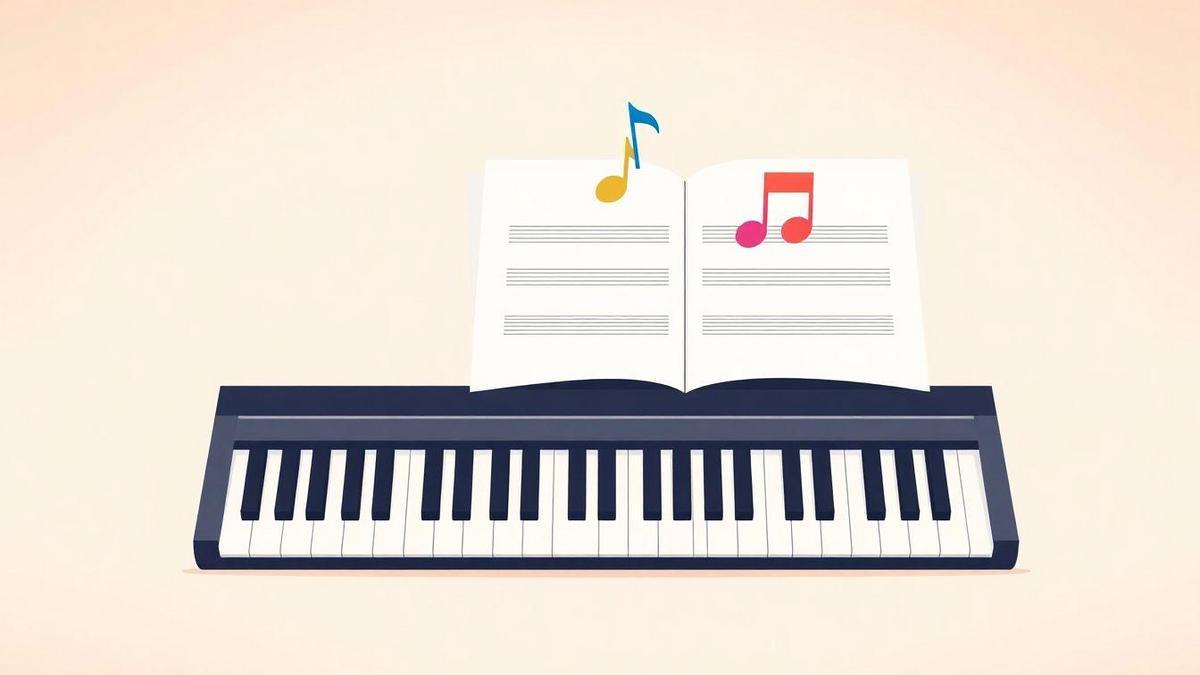A beginner’s guide to harmony you can actually use
Quick, practical steps I use to hear, build, and apply harmony to real songs. This is A beginner’s guide to harmony you can actually use — not theory for theory’s sake, but drills, voicings, and simple rules you can apply at the instrument. If theory feels intimidating, see demystifying music theory for a practical perspective.
Key takeaway
- Start with simple major/minor chords.
- Sing the main note to stay in key.
- Add one harmony note at a time.
- Match your voice to chord tones.
- Practice with short, focused drills or a loop.

What intervals are and why they matter
An interval is the distance between two notes — the basic building block of harmony. If you can hear intervals (seconds, thirds, fifths, octaves), you can tell when melody and chord agree (consonance) or clash (dissonance), choose chord tones that support a melody, and write harmonies that feel natural. If you want concrete listening examples and simple exercises, check musical intervals made simple with real examples. This practical approach is the core of A beginner’s guide to harmony you can actually use. For formal breakdowns and listening exercises, see Fundamentals of musical intervals and hearing.
Simple listening drills (5 minutes)
Keep drills short and focused. One interval at a time.
Basic pattern:
- Pick a root (middle C or an open guitar string).
- Play/sing the root, then the target interval (root → third, etc.).
- Say the name aloud: root, third. Repeat 8–12 times.
- Switch intervals: thirds → seconds → fifths → octaves.
Quick tips:
- Focus on sound quality (bright = major, dark = minor).
- Play and sing together. Slow to hear detail, fast to reflect music.
- Mark stable intervals (fifths, octaves) vs. tense intervals (seconds, some thirds).
- Use a steady tempo — if you need help staying patient with a click, see how to use a metronome without losing patience.
For short ear-training drills and techniques, check Short ear-training drills and techniques.
Short practice drill:
- 5 minutes total. Start with thirds (8–12 reps), then seconds, fifths, octaves.
- End by naming intervals you hear; correct = keep, wrong = repeat.
- Sticky note: listen, sing, name.
How to build triads and seventh chords
Stack notes by thirds from a scale — like stacking bricks. Pick a scale (C major is easiest), number it 1–7, then stack every other degree. If scales feel fuzzy, review scales explained in plain English.
- Triad: 1 3 5
- Seventh chord: 1 3 5 7
Chord formulas (C root):
| Chord type | Notes | Formula | Sound |
|---|---|---|---|
| Major triad | C–E–G | 1 – 3 – 5 (M3 m3) | Bright, stable |
| Minor triad | C–Eb–G | 1 – b3 – 5 (m3 M3) | Sadder, softer |
| Dominant 7th | C–E–G–Bb | 1 – 3 – 5 – b7 | Pushes to resolve |
| Major 7th | C–E–G–B | 1 – 3 – 5 – 7 | Lush, dreamy |
| Minor 7th | C–Eb–G–Bb | 1 – b3 – 5 – b7 | Warm, mellow |
For a broader look at what chords are and why they behave this way, see what chords are and why they matter.
A concise reference on triad construction is provided here: How triads and chord tones stack.
Quick chord-spelling tip:
- From the root, skip one scale note to get the next chord tone.
- Lowered 3rd = b3 (minor); lowered 7th = b7 (dominant/minor7).
- Add the seventh, listen: if it pushes, it’s a dominant 7th; if it softens, it’s a major/minor 7th.

Reading and using simple chord progressions
Treat progressions like a short story: find the home chord (I), the push (V), and the release (I). If you need help decoding chord symbols and basic notation, consult how to read chords and sheet music.
Common patterns in C major:
- I–IV–V: C – F – G (bright, driving — rock/blues)
- ii–V–I: Dm – G – C (smooth, jazz/pop ballad)
Chord function:
- Tonic (I) = home.
- Subdominant (IV/ii) = preparation.
- Dominant (V/V7) = push/tension.
Progression Checklist:
- Identify the key → find I.
- Label functions: Tonic / Subdominant / Dominant.
- Try I–IV–V or ii–V–I first.
- Add color: 7ths, minor iv, sus chords.
- Check bass motion — stepwise is smoother.
- Play and sing; tweak one thing at a time.
For a practical guide to chord progression functions, see Practical guide to chord progression functions.
Harmonizing melodies — step by step
Treat a melody like a roadmap. Find the key, list scale notes, and for each melody note ask: which chords contain this note (1, 3, or 5)? If you need a low-stress way to write melodies and pair chords, see writing your first melody without overthinking.
Scale-note → common chords (in C):
| Note | Chords containing it |
|---|---|
| C | C, Am, F |
| D | Dm, G |
| E | C, Em, Am |
| F | F, Dm |
| G | G, Em, C |
| A | Am, F, Dm |
| B | Em, G, C (leading-tone contexts) |
Example (melody: E — D — C — G):
- E → C / Em / Am (C is stable)
- D → Dm / G (G pulls back to C)
- C → C / Am / F (landing point)
- G → G / Em / C (resolve or soften)
Harmonization flow:
- Identify key and melody notes.
- List chords that contain each melody note.
- Prioritize chord tones on strong beats.
- Choose chords sharing tones with the previous chord for smooth voice leading.
- Try a stable option (I/IV/V) and a color option (iii/vi/ii) and pick what fits the lyric/mood.
For more on how chord tones fit melodies, the overview of what chords are and why they matter is a nice companion.
Voice leading made usable
Keep shared notes (common tones) and move other voices by step to keep harmony smooth and singable.
Rules:
- Keep common tones when possible.
- Move other voices by step rather than leap.
- Let the bass take larger leaps if needed.
- Avoid parallel fifths and octaves.
- If you leap, follow with stepwise motion.
- Keep the top voice singable.
Three-voice exercise:
- Choose I–IV–V–I. Write bass, middle, top. Keep one common tone, move others by step, sing each voice.
Avoid common beginner pitfalls (like overcomplicating voicings or ignoring voice-leading basics) covered in seven beginner mistakes that slow music progress. If you want deeper lectures on harmony and voice leading, see Lecture materials on harmony and function.

Three easy harmonization techniques
These are practical, song-ready tricks from A beginner’s guide to harmony you can actually use.
- Parallel thirds
- Add the third above the melody (stay diatonic). Sweet and easy. Avoid when the melody jumps far.
- Block harmony (triads under melody)
- Root, third, fifth held for a bar or two. Use the same rhythm to create a stable bed.
- Pedal tone & counter‑melody
- Pedal: hold a low root or fifth while chords change above (e.g., hold low C under C–Am–F–G).
- Counter‑melody: write a simple, complementary tune (simpler than the main melody, often opposite motion).
For using harmony to shape feeling and phrasing, see how to add emotion to every note.
Practice set (4 bars):
- Play melody 4x. Add thirds 4x. Try thirds below.
- Convert to block harmony: root-position then 1st-inversion triads.
- Add a pedal tone for 8 bars and try two chord patterns above it.
- Write a 2-bar counter phrase and repeat under the melody.
- Record and fix one thin spot.

Blending melody and harmony for songwriting
Let the melody lead; use harmony to shape phrasing and emotion. Ask: bright, sad, tense, or cozy? Pick chords to match that feeling. For quick tips on turning single notes into expressive lines, read how to add emotion to every note.
Simple plan:
- Hum the melody and mark strong beats.
- Find the scale and chord pool.
- Put chord tones on strong beats; allow passing tones on weak beats.
- Use a 7th or 9th sparingly for color and resolve to chord tones.
Voicings and inversions:
- Put the chord’s closest chord tone under the melody.
- Use 1st inversion to smooth bass motion.
- Keep common tones; change one or two notes per chord.
Guitar tips:
- Move a single finger to change shapes. Use partial barre or 3-note shapes. Use open strings as drones.
Piano tips:
- Left hand: bass essential chord tones. Right hand: melody.
- Put 3rd or 7th in left hand for color; double melody in octaves for power then back off.
Songwriting checklist:
- Is the melody clear on strong beats?
- Do strong-beat melody notes match chord tones?
- Do voicings move smoothly?
- Are tensions resolved intentionally?
- Can I simplify a chord without losing color?
Daily practice routine (10 minutes)
Treat harmony like a short workout. For a simple daily plan you can actually stick to, see how to create a simple practice routine — daily, and if you need motivation hacks, try making practice fun instead of a chore or how to stop procrastinating on music practice.
Daily 10-minute routine:
- Warm-up (2 min): hum a pitch, gentle sirens.
- Interval focus (3 min): sing root → target (major/minor 3rd, 5th).
- Arpeggio work (3 min): play I–IV–V broken, sing chord tones.
- Record & reflect (2 min): 30–60s clip, note one fix for tomorrow.
Log progress: date, drill, one note. Repeat drills until easy, then add a tiny twist (new key/tempo).
Apply the guide to your instrument
Adapt shapes to your skill: choose easy guitar voicings or small piano hand spans. Drop nonessential notes (a missing fifth often still sounds full). Use inversions to minimize hand movement.
Quick reference (easy voicings):
| Chord | Guitar | Piano |
|---|---|---|
| C | x32010 | C–E–G |
| G | 320003 | G–B–D |
| Am | x02210 | A–C–E |
Simplify when stuck:
- Ask: which notes sound like home, which want to move?
- Try I first, then IV or V. One will usually fit.
- Use vi or iii as a single color spice.
Quick arranging tips:
- Use space. A single sustained chord can be powerful.
- Move one voice at a time. Small shifts sound smooth.
- Use inversions for stepwise bass.
- Add a passing chord for a short lift (I → ii → V → I).
- Record rough demos and cut what feels heavy.

Conclusion
Practical moves win: train your ear on intervals, stack by thirds to build triads and sevenths, let the melody lead and let chords follow. Keep practice short and repeatable — 5‑minute interval drills and a 10‑minute daily routine beat marathon sessions. This is A beginner’s guide to harmony you can actually use: pick one tool, try it, tweak it, and repeat. Listen, sing, name — small, intentional steps make harmony click. For other tips I wish I’d known early on, see what I wish I had known.
For more practical lessons and drills, visit ClickNeutro.
